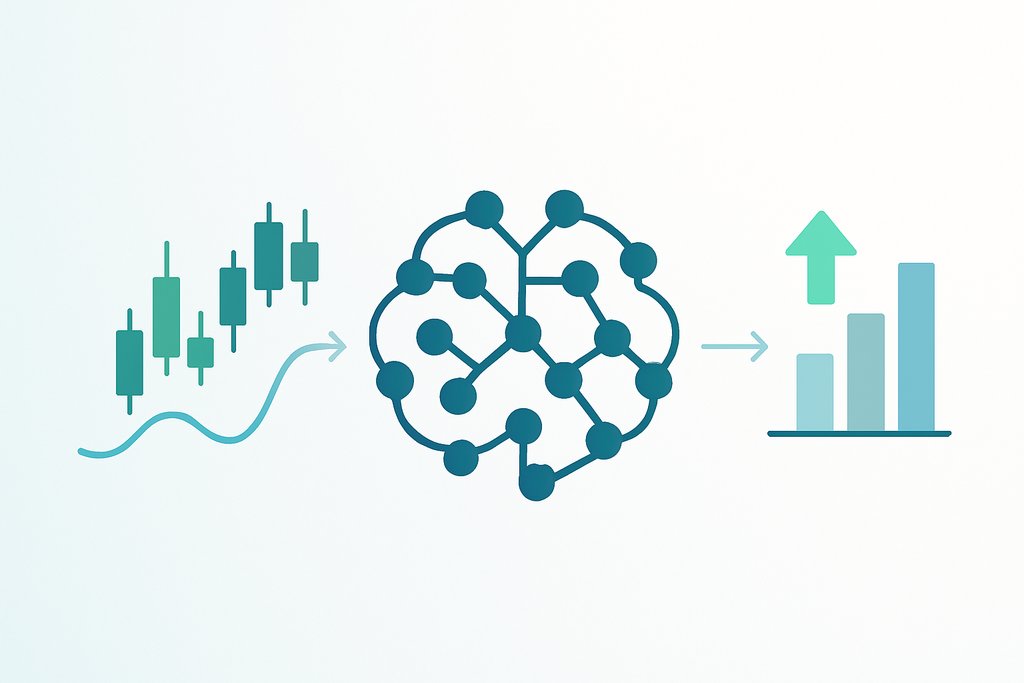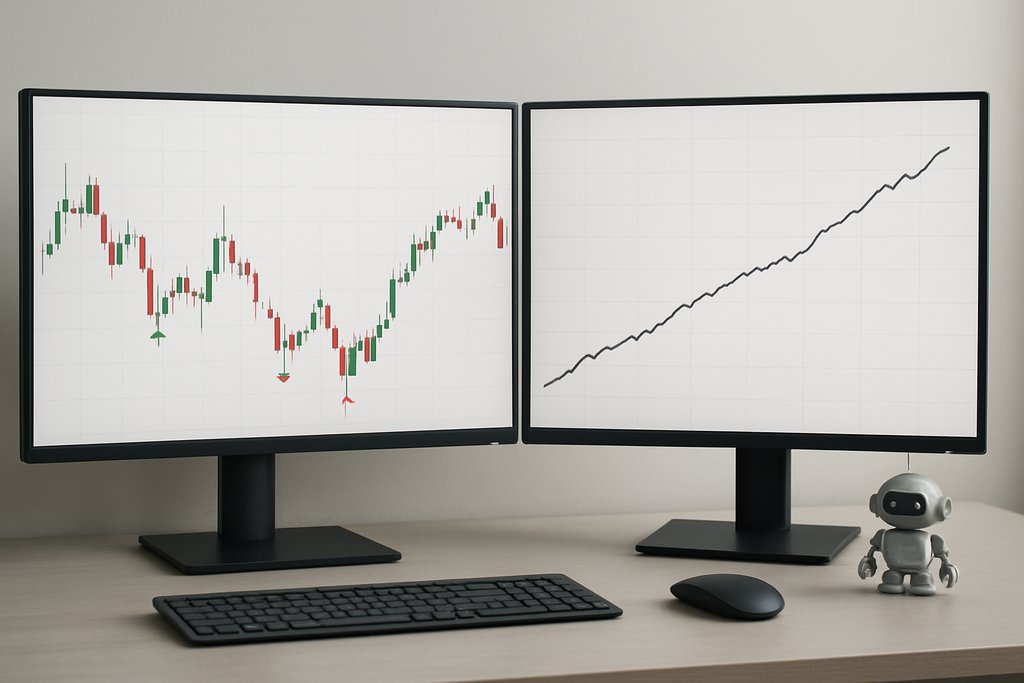AI Trading Bot: What It Is and How to Build One That Trades
Learn what an AI trading bot is, how it works, and how to build one that actually trades without code. See how Obside turns plain English into live strategies in minutes.

Table of contents
- What is an AI Trading Bot?
- How an AI Trading Bot Works
- AI vs Rule-Based Automation
- Build Your First AI Trading Bot With Obside
- Practical Examples and Templates
- Benefits and Considerations
- Metrics That Matter
- Obside at a Glance
- Conclusion and Next Steps
- FAQ
- Related articles
If you are searching for an ai trading bot, you likely want an edge that does not rely on staring at charts or clicking buy and sell by hand. You want automation that can react to prices, news, and volatility with machine speed and discipline. The catch is that many people either get lost in code or use bots that overfit and fail when conditions change. This guide explains what an ai trading bot can and cannot do and shows how to build one that moves from idea to execution without code.
What is an AI Trading Bot?
An ai trading bot is an automated system that uses artificial intelligence to analyze data and make trading decisions from learned patterns. Unlike a purely rule-based bot that follows fixed if-then logic, an AI-powered bot can weigh many inputs at once, adapt to changing conditions, and improve with retraining. It can support the full trade lifecycle, from signal generation and risk sizing to order execution and review.
In practice, an ai trading bot may combine technical indicators with models trained on historical prices and order books, plus unstructured information like headlines or social posts. It can monitor multiple assets, execute with predefined risk controls, and remove emotional bias while keeping reaction time low. The goal is a stable, enforceable process.
How an AI Trading Bot Works
Most productive AI trading systems follow a repeatable pipeline. The stages below help you understand where edges appear and how to keep them live.
Data and features
Inputs often include prices, volumes, spreads, volatility measures, calendar effects, and classic indicators like RSI and MACD. Many systems add text signals from news or company events. If you need a refresher, see a clear overview of RSI and a guide to MACD on Investopedia.
Modeling
Popular choices include gradient boosted trees for tabular data, recurrent or transformer networks for sequences, and logistic or linear baselines. The aim is not certainty, but a consistent, small edge that remains after costs.
Backtesting and validation
Use walk-forward validation, keep in-sample and out-of-sample periods separate, and model realistic costs. This reduces overfitting and data snooping. See overfitting and generalization for context on why it matters.
Execution
Execution quality often matters as much as prediction accuracy. A robust bot routes market or limit orders based on liquidity, staggers entries, and enforces risk limits like max position size, stop loss, and daily loss caps.
Execution quality often matters as much as prediction accuracy.
Monitoring and retraining
Models degrade when regimes shift. Ongoing monitoring, alerts, and scheduled retraining keep the edge alive and contained.

When to Use AI vs Rule-Based Automation
AI is useful when you need to combine many weak signals, capture nonlinearity, or interpret text and events. Detecting the impact of a tariff on industrials or how a volatility spike changes breakout odds are good examples. By contrast, rule-based systems shine for time-based rebalancing, simple momentum on a single timeframe, or risk overlays like trailing stops.
Many resilient approaches mix both: the AI model scores opportunities while a rule layer enforces sizing, stops, and portfolio constraints. If you are building your first system, see how to structure rules in a practical trading strategy guide and compare styles in the types of trading overview.
Build Your First AI Trading Bot, Step by Step, With Obside
You do not need to write code to launch an ai trading bot that trades real markets. Obside turns plain English into live alerts, automated orders, and portfolio strategies. You describe what you want, backtest instantly, and deploy to your connected brokers and exchanges.

- Create your account and connect a broker or exchange. Start at Obside Register, link your brokerage or exchange, and begin in paper trading to learn safely.
- Define a clear objective. Choose your priority: smoother equity growth, higher Sharpe, or higher hit rate with small wins. These choices shape risk and sizing.
- Describe your strategy in natural language. Example: Buy when there is a bullish divergence on RSI on a 15 minutes chart, set a stop loss on the low of the day and a take profit at 10%.
- Add alerts and filters. Ask, Alert me if Bitcoin rises above 150,000 dollars and daily volume doubles, or Tell me when OpenAI announces a new AI model. Use alerts to guard against low-quality setups.
- Backtest in seconds. Obside shows Sharpe, max drawdown, profit factor, and hit rate. Favor out-of-sample tests and walk-forward periods to reduce overfitting.
- Set risk and execution. For example: risk 0.5% per trade, max 3 open positions, trailing stop at 5 ATR on the 2h chart, and a 2% daily loss cap.
- Go live and monitor. Deploy in paper, then live. Track drawdown, expectancy, and turnover. Add a rule to pause after a daily loss limit and resume the next day.
When Supertrend is bullish on 2h and RSI < 70, buy.
Place trailing stop at 5 ATR (2h). Close if Supertrend flips.Practical Examples and Templates for AI Trading Bots
Use these templates in Obside to combine AI scoring with transparent execution rules. They show how to blend price action, events, and risk management.
Score breakout quality by blending momentum, volume expansion, and volatility contraction. Rule layer: when the Supertrend is bullish on the 2h chart and RSI is not overbought, buy. Favor setups where volume exceeds the 20-day average by 50%. Use a 5 ATR trailing stop and exit if Supertrend flips.
Use a language model to classify headlines for context. Example: Alert me if Apple announces a new product, then buy the pullback if the first 15 minutes retraces 30% to 50%, with a stop under the 5-minute swing low.
Classify periods as risk-on or risk-off with credit spreads, volatility indices, and commodity trends. Run your crypto trend-following only in risk-on; switch to dollar-cost averaging when risk-off persists for two weeks.
Portfolio targeting can mix AI with constraints. For instance, keep 50% in Bitcoin, 25% in Ethereum, and 25% in USDC, while capping portfolio volatility at a target. Rebalance weekly and suspend buys if realized volatility exceeds a threshold for three days. You can formalize these rules in plain language and iterate quickly with Obside’s backtester.
Event and social triggers can add useful context: Buy 1000 dollars of Bitcoin if the price is below 100,000 dollars and open interest increases while funding rates stay neutral. Or Sell all my positions if the S&P 500 drops by 10 percent intraday and breadth falls below 20 percent advancing.
Benefits and Considerations of AI Trading Bots
- Removes hesitation and enforces discipline
- Monitors many assets in parallel
- Iterates fast with instant backtests
An ai trading bot responds to new information faster than a human and supports diversification across multiple independent strategies. With Obside, you get instant backtests and smooth deployment to brokers and exchanges.
Key considerations include overfitting, costs, and drift. Slippage and commissions can erase a fragile edge. Simulate them, prefer liquid markets, and monitor performance with alerts and scheduled retraining. Risk management is non-negotiable: position sizing, stops, daily loss caps, and portfolio limits help you survive bad periods and compound over time.
Metrics That Matter for an AI Trading Bot
Do not stop at total return. Review the Sharpe ratio for return per unit of volatility, the Sortino ratio for downside focus, and maximum drawdown to understand worst-case pain. Profit factor, expectancy, win rate, exposure, and turnover complete the picture. Most importantly, compare in-sample with out-of-sample and live results after costs. If live performance tracks expectations, your process is likely robust.
For deeper reading, see the practical AI investing guide and revisit your testing approach in the strategy build-and-test guide.
Obside at a Glance for AI Trading Bots
Obside helps traders go from idea to execution in seconds. Describe your logic in plain language, from smart alerts to full portfolio strategies. The platform handles alerts tied to prices, indicators, news, and macroeconomic data, places automatic orders, and manages positions with stops, targets, and rebalancing. Its ultra-fast backtesting engine lets you validate changes quickly, connect brokers and exchanges, test on paper, and go live when ready.
Use cases include alerts such as Alert me if Bitcoin rises above 150,000 dollars and daily volume doubles, indicator logic like Notify me if RSI crosses 70 on EUR/USD and MACD turns bearish, and strategies such as Buy 50 dollars of Bitcoin every Monday at 10:00 AM or Keep 50 percent of the portfolio in Bitcoin, 25 percent in Ethereum, and 25 percent in USDC.
Conclusion and Next Steps
An ai trading bot is not a crystal ball. It is a disciplined process that uses data, models, and automation to create a repeatable edge. Keep your objective clear, collect quality data, validate honestly, and enforce risk rules. Start out of sample, go live small, and iterate as you learn.
If you want to skip the heavy lifting and still control your logic, try Obside. Describe your strategy in natural language, backtest in seconds, and deploy to your connected broker with risk controls in place. Begin with one focused bot, validate it, then expand to a set of uncorrelated strategies.
Create your free Obside account
FAQ: AI Trading Bot
Do ai trading bots really work?
Yes, when built and validated correctly. You need a modest, consistent edge that survives costs plus strong risk management. Most failures come from overfitting or ignoring slippage. A robust process uses out-of-sample testing, walk-forward validation, and realistic execution, then monitors live performance. Platforms like Obside help you apply that discipline without coding.
How much capital do I need to run an ai trading bot?
It depends on market, costs, and turnover. As a rule of thumb, risk 0.5% to 1% of equity per trade. Start in paper trading, go live small, and scale only after live results align with backtests.
Can I run multiple AI bots at the same time?
Yes. Diversifying across uncorrelated strategies can reduce drawdown and improve risk-adjusted returns. In Obside, you can run several strategies simultaneously, each with its own rules and risk limits, and monitor them from one dashboard.
How do I reduce overfitting in my ai trading bot?
Prefer simpler models, limit features, and use walk-forward validation. Penalize complexity, include transaction costs in tests, and require that results persist across time and assets. Retrain on a schedule and monitor live metrics. If live results diverge, pause, review, and adapt.
What are good targets for performance metrics?
Targets vary by market and horizon. Many short-term systems aim for a Sharpe above 1 after costs with max drawdown under 15% to 20%. Longer-term approaches often prioritize lower turnover and steadier equity curves over raw return. Decide your objective first.
Can an ai trading bot trade from news and events?
Yes. Using NLP, a bot can classify headlines or events and combine them with price filters. Example: Alert me if Apple announces a new product, then enter on a measured pullback with defined risk. Obside supports news-based conditions described in plain language.
